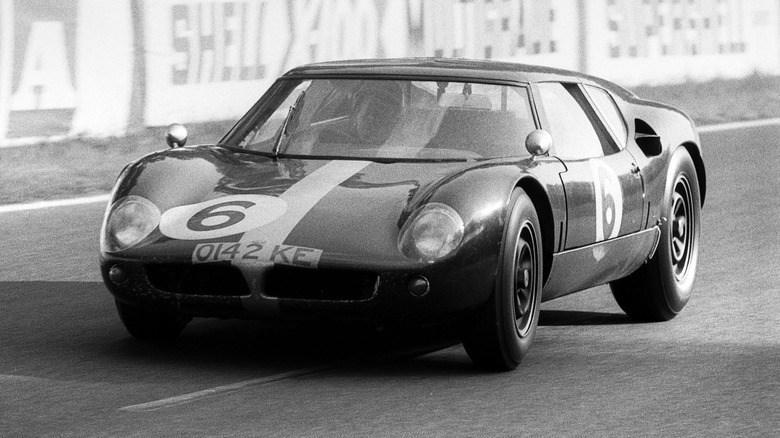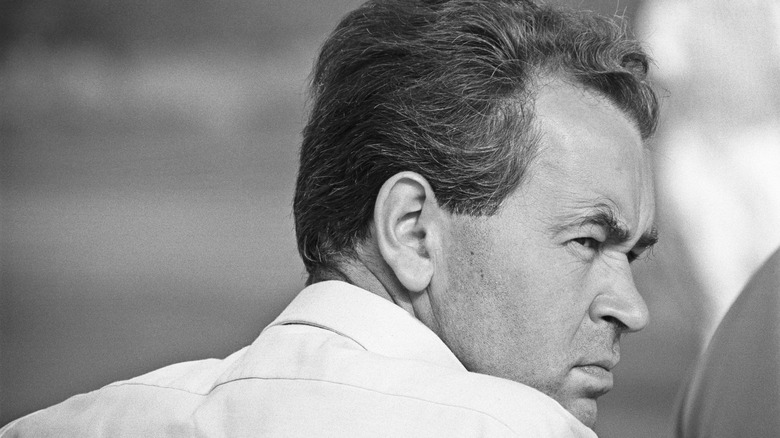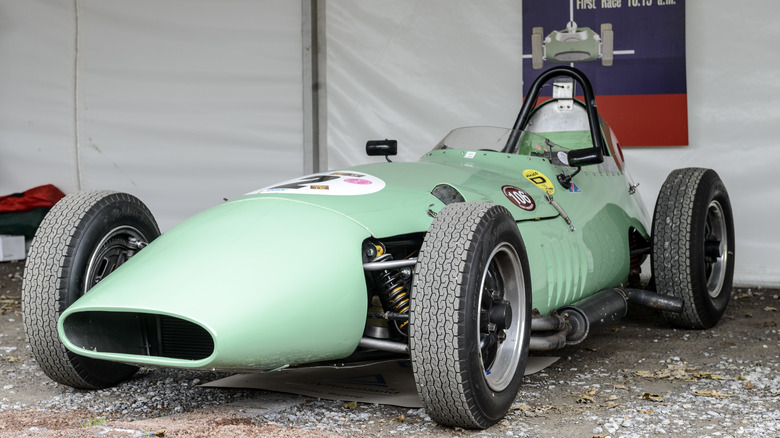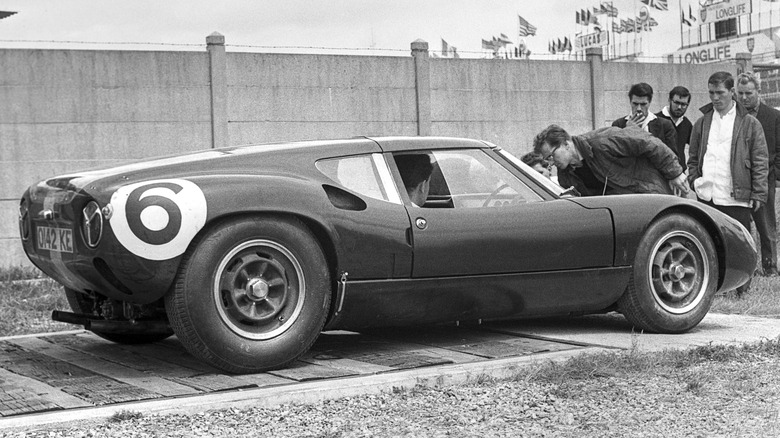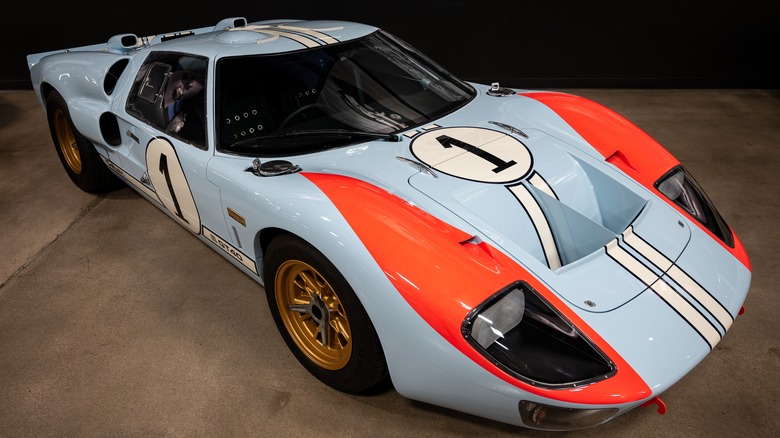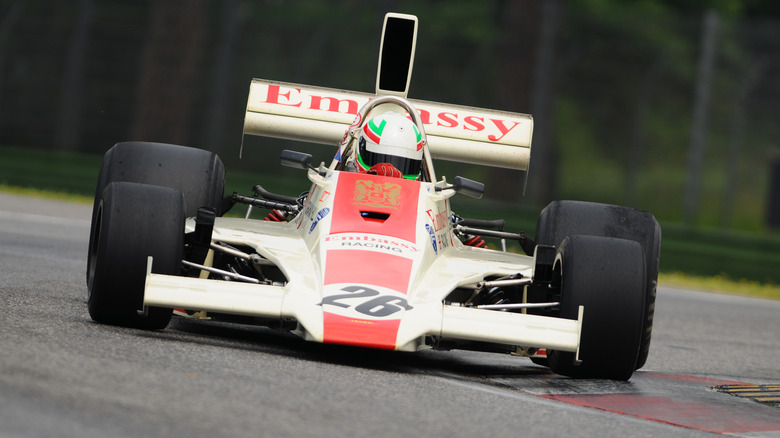All About The Lola MK6 GT: The Car That Inspired The Ford GT40
The Ford GT40 is one of the best-known performance cars to grace racetracks worldwide. Its development was borne of a feud between Henry Ford II and Enzo Ferrari over who could triumph at the grueling and historic 24 Hours of Le Mans.
The original mid-'60s GT40s, the 2005 and 2017 Ford GT updates, and the Ford GT Mk IV Supercar that arrived in 2023 have captivated fans of automobiles, racing, and even cinema for decades. Immortalized in the 2019 Hollywood blockbuster "Ford v. Ferrari," the story of how Ferrari and Ford II came to blows over which builder was superior has refocused the spotlight on the aggressive curves of a powerful and timelessly beautiful machine.
Carroll Shelby, legendary racer and progenitor of another classically beautiful race machine immortalized in one of America's most popular kit cars, is famously linked to the GT40. He — along with engineer Roy Lunn — headed up the project that would see the GT40 sweep the podium at the 1966 Le Mans endurance race. What fewer people realize is that the original design for the GT40 was not the brainchild of Ford or Shelby at all. However, the lesser–known car behind the legendary story comes from a far smaller race team with a no less storied history.
Upon the formation of the Ford Advanced Vehicles Group -– the division of Ford assigned to develop a car to best Ferrari –- Lunn traveled to England to visit the Lola racing team. In the team's garage sat the Lola Mk6 GT. Lunn convinced the team to sell him two of the three existing racers and took them home and turned them into world beaters. This is the story of the car that served as the basis for Ford's greatest triumph.
Eric Broadley and Lola Racing
Eric Broadley started his professional career as a cabinetmaker, which may seem an unlikely genesis for the progenitor of one of history's greatest cars. Born in 1928 to a clothing seller who encouraged him into a trade, Broadley worked as a surveyor and a cabinet carpenter before discovering his true passion — racing.
His first ventures into racing included membership in the 750 Motor Club, which allowed him to get behind the wheel of a self-designed car known as the Broadley Special. Broadley used a 1,100 cubic centimeter (cc) engine inserted into an Austin 7 chassis to create the vehicle, and was able to win a championship with it. The subsequent desire for his cars helped fund what would become a lifelong involvement in auto racing that would see him move into Formula and IndyCar as a designer.
Broadley soon abandoned the driver's seat to focus on design. The result of that initial demand for his cars evolved into the Lola Mark 1, a low–slung and curvaceous racer that was powered by a 1,000 cc engine from a Coventry Climax. The Mark 1 developed into the Mk2, a front-engined single-seat rocket with a double wishbone suspension. Lola's chassis design caught the attention of race teams and in 1962 the team would step up to Formula 1.
Lola Cars Limited
Broadley and Lola did not dominate F1 racing as they might have wished, but they still created a company that developed dozens of cars. Lolas would appear in everything from Formula 1 and open-wheel Indy racing to endurance events. Starting with Broadley's win in 1957, Lola has topped the podium in the BRSCC Sports Car Championship, the SCCA, Can-Am, the Formula Super Vee Gold Cup, and the PPG Indy Car World Series along with dozens of other series dating all the way up until 2022.
In the mid-'90s, Broadley wanted to race in Formula 1 under his own banner. Until then, he had primarily provided chassis' for the Larousse team, acting as team principal. After scoring a sponsorship from MasterCard, Lola joined F1 for the 1997 season. Engine design delays resulted in a lack of track and wind tunnel testing, which meant that the team performed poorly and only lasted a single season before sinking under the weight of £6 million worth of debt.
Despite a poor showing in F1, Lola's dedicated development showcased a huge amount of success. Broadley showed a special affinity for using Ford V8s, with the occasional Chevrolet mixed in. The car that would ultimately lead to the GT40 started out as the Lola Mk1 GT. By the time they caught the attention of Roy Lunn, they were up to a Mk6.
Lola Mk6 GT
The original 1,100 cc 750 Motor Club winner was dubbed the Lola. Eager to improve on his success, Broadley raised £600 by selling the original Lola and further added to his budget through the sale of his personal motorcycle. Sticking with an 1,100 cc Coventry Climax as the base motor, he molded a tubular chassis and went racing again. Further success on the track produced offers from other teams to buy Mark 1s. With the proceeds from these profits, Broadley established Lola Cars Limited.
Ditching the Coventry 4-cylinder for a 1.5 L Coventry V8 for Lola's debut in F1 in 1962, the Lola Mk4 was an open-wheel racer with a fiberglass body. It made its Championship debut at the Dutch GP in 1962, scoring pole position but retiring when a wishbone broke during the race. These vehicles left no question that Lola made some interesting and competitive — not to mention beautiful — race cars. The MkV was similarly an open-wheel design that competed in the 1962 F Junior series. Still, it was the 1963 Lola Mk6 GT would catapult the manufacturer into the highest echelons of racing.
From Mk6 GT to GT40
By 1963, Lola had become reliant on Ford V8s. Their monocoque design employed a 4.2 L Ford small block engine nestled in a chassis and attached to a running gear designed by Broadley himself. In fact, the body of the 1963 Lola GT bears close resemblance to what would eventually become the GT40. The curved fenders bordering a flattened hood with a sloping rear deck covering a midship engine all had the hallmarks of what Ford ultimately fielded at Le Mans. John Frayling — a veteran of the Lotus Elite program — was responsible for the distinctive look.
Roy Lunn, head of the Ford Advanced Vehicles team created by Henry Ford II to beat Ferrari, flew to England. Upon inspecting the Lola GTs, Lunn promptly purchased two of the three existing models and transported them back to Slough in the U.K. – where the Ford program was initially based — and got to work using them as test vehicles.
Broadley himself was initially part of the deal, but quickly got fed up with corporate politics and left the Ford engineers to do their own thing with his designs. The Ford Advanced Vehicles group worked through 1964 and 1965 to lighten and modify the GT models with mixed results at endurance races. Scoring a handful of DNFs the first year, Ford roared back with some podiums the second. However, it wasn't until Roy Lunn shifted to engineering head and Carroll Shelby was brought in as overall lead to cram his preferred 427 cubic-inch big block V8 into the midship engine bay that the GT40 scored their legendary 1-2-3 win at the 1966 Le Mans.
Future of Lola
Ultimately, the Lola would be forgotten by all except dedicated gearheads as the genesis for one of the greatest racing victories ever, but Lola itself would prevail. Despite staying relatively under the radar, the company, under the ownership of Till Bechtolsheimer since 2022, is still breaking speed records.
Eric Broadley passed away in 2017 at the age of 88. His contribution to one of the most legendary episodes in the annals of racing history is largely forgotten. However, the quiet man who spent his life at the racetrack is remembered for his genius designs and sterling racing reputation.
The Lola GT has a timeless aesthetic that remains beautiful to this day. It's no coincidence that Ford continues to reinvent the GT40 upon which it was based with updated features and performance. Lola continued racing well into the 2000s in a variety of classes, becoming one of the winningest race organizations ever to grace the payment.
